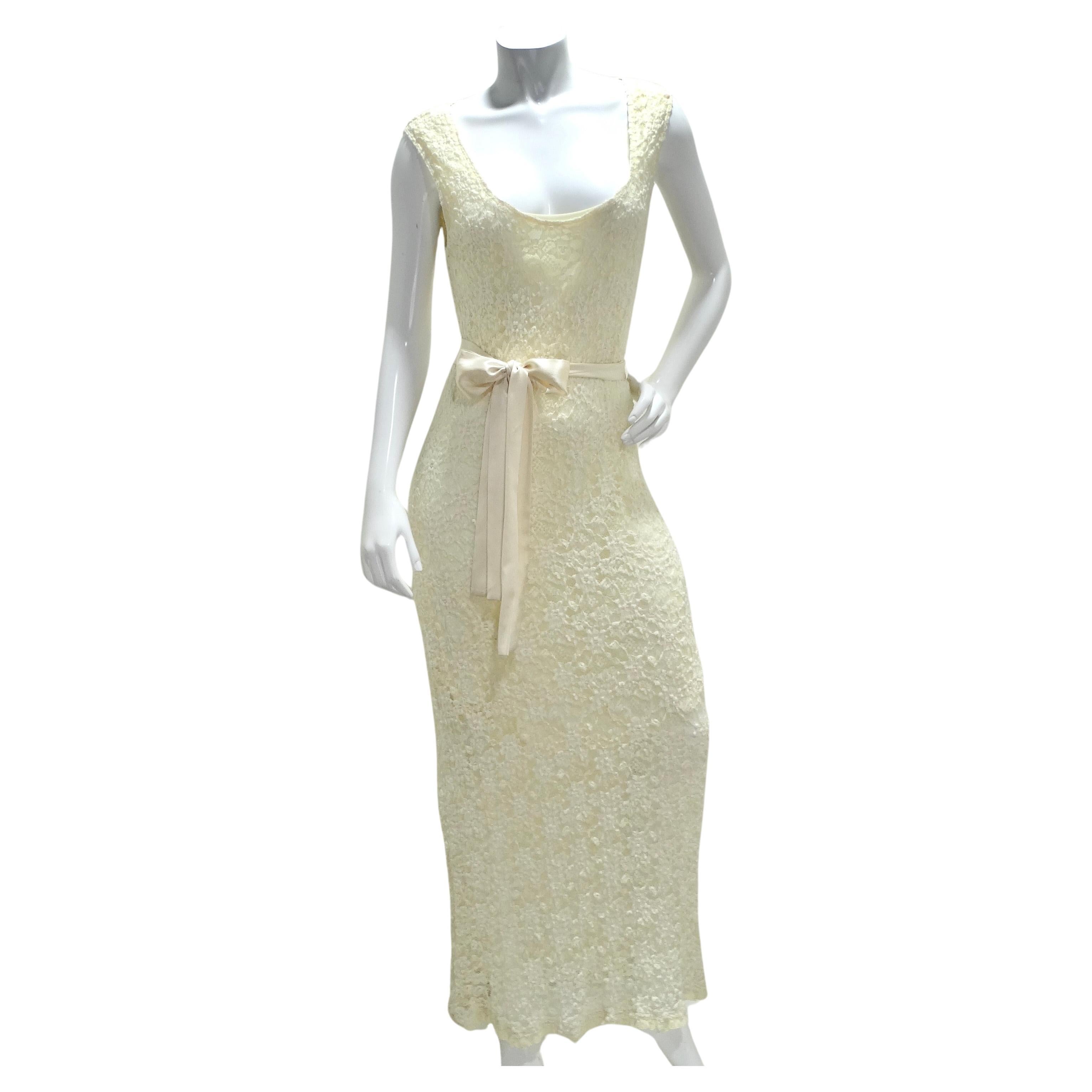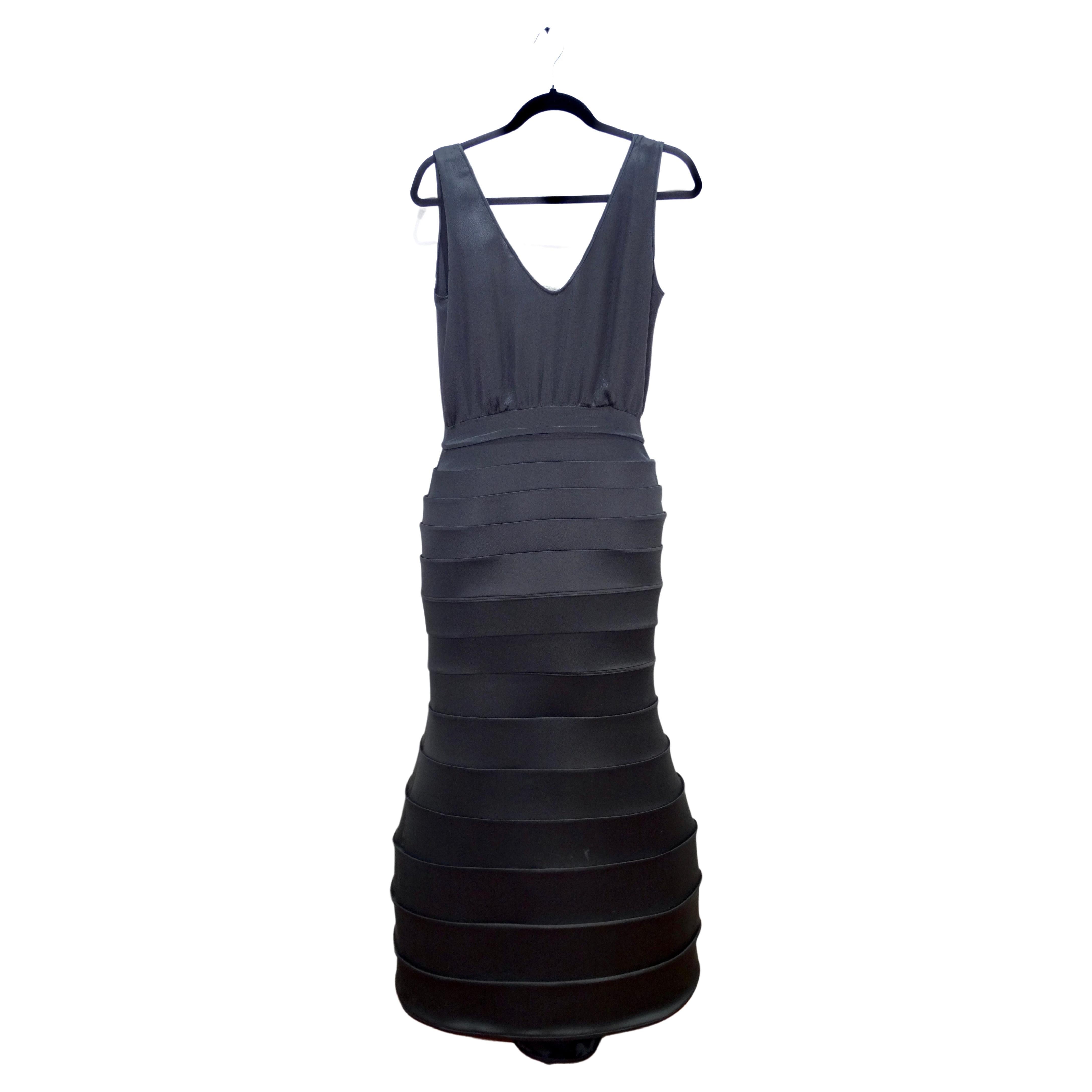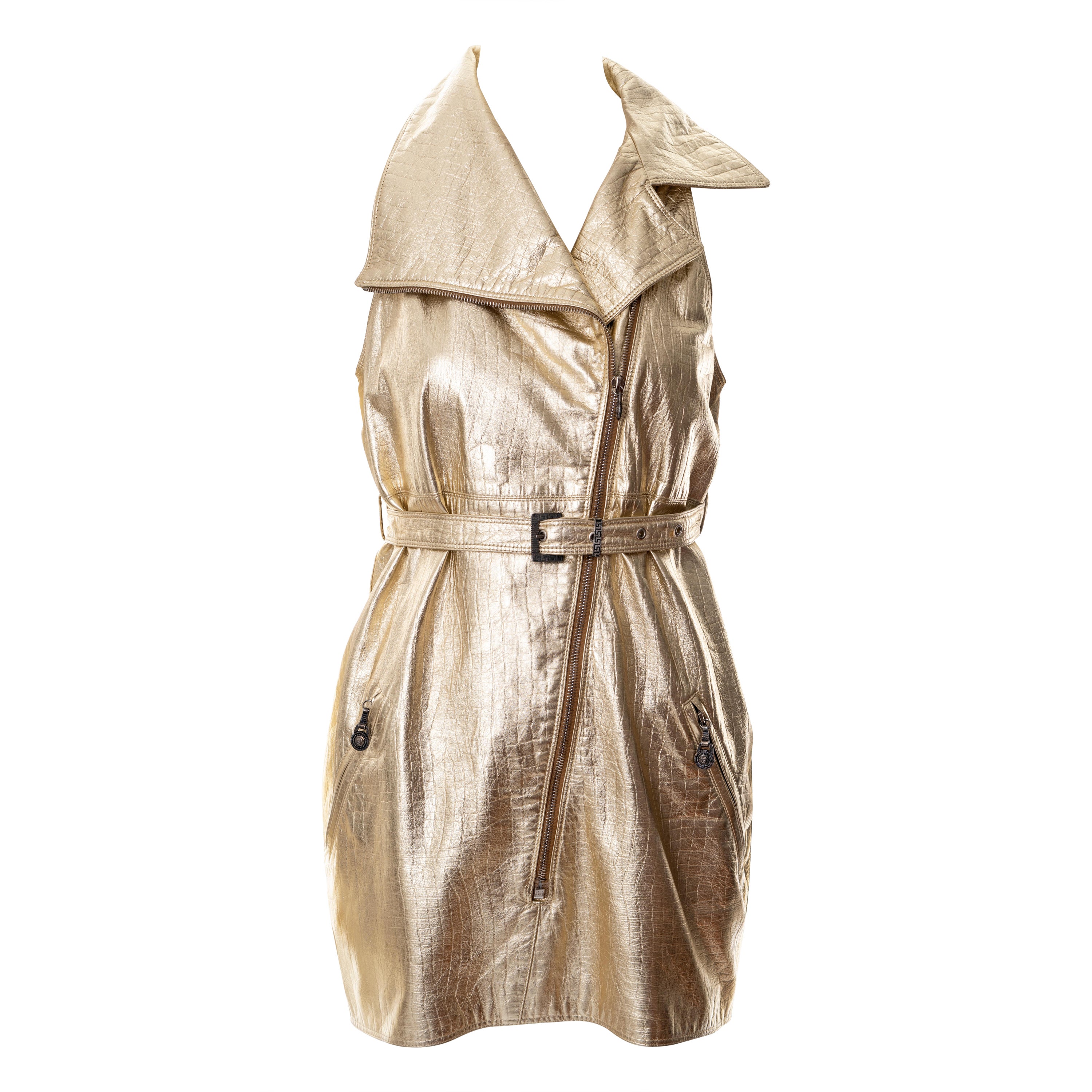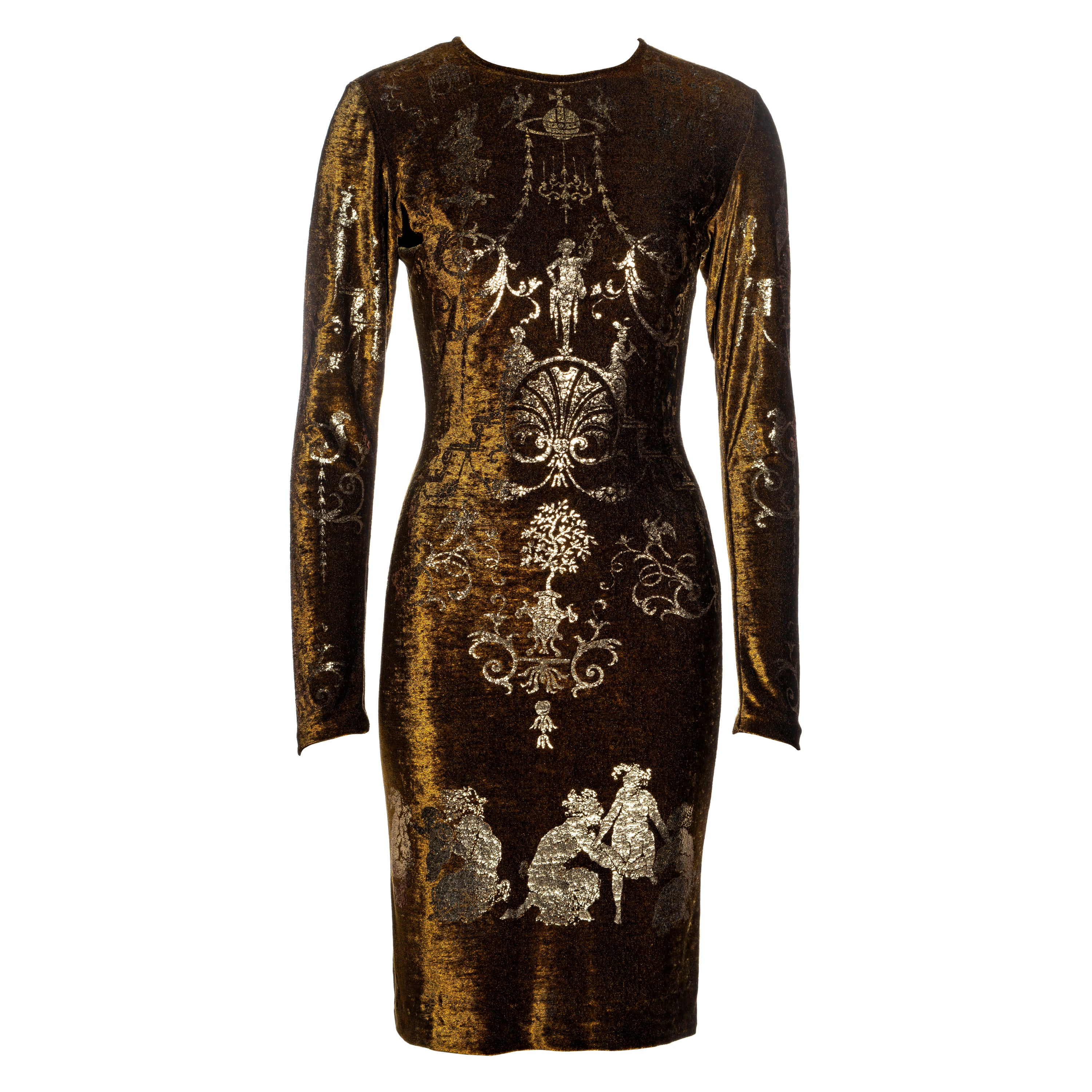MartinMargiela 1990 1stRetrospectiveCollection1994 Sheer Black Convertible Apron
About the Item
- Designer:
- Brand:
- Dimensions:Marked Size: IT40/US 6; one size can fit most (EU)
- Style:minimalist (In the Style Of)
- Place of Origin:
- Period:
- Material Notes:The designer encouraged buyers since Fall 1990 to add crease or wrinkle patterns to his fabrics that can be impressed with an iron to appear discarded in old age or forgotten since folded in storage.
- Condition:Wear consistent with age and use.
- Seller Location:Chicago, IL
- Reference Number:1stDibs: LU3244222701972
Maison Martin Margiela
Belgian designer Martin Margiela (b. 1957) — whose life, career, clothing designs and vintage shoes have become cult-collector obsessions — pushed those who attended his shows outside their comfort zones. In the years following his maison's 1988 debut, he toyed with creative and aesthetic paradoxes that persist in fashion today.
Consider the Spring/Summer 2001 shirt patchworked from vintage clothing labels, or his famous corset dresses made from tailoring dummies, from his Fall/Winter 1997 line. Or his oversize collection for Fall/Winter 2000. In 1992, Margiela told Dépêche Mode magazine, “My clothes appeal to women of a certain mindset rather than of a specific age or physique.”
Born in Genk, Belgium, in 1957, Margiela knew he wanted to be a fashion designer after catching glimpses of Parisian fashion on TV as a child. Although his parents discouraged this career choice as an oddly funny aspiration, Margiela enrolled in the fashion program of the Royal Academy of Fine Arts Antwerp. There, he befriended and graduated a year ahead of the Antwerp Six — the acclaimed group of Belgian fashion designers comprising Dries Van Noten, Walter Van Beirendonck, Ann Demeulemeester, Marina Yee, Dirk Bikkembergs and Dirk Van Saene.
Like many of his contemporaries in the 1980s, Margiela understood Paris fashion but felt a deep resonance with the deconstructed beauty espoused by Japanese designers Yohji Yamamoto and Rei Kawakubo, of Comme des Garçons. Margiela’s fascination with Japan influenced many of his earliest collections and designs, from a dress pieced together from broken plates to his iconic Tabi boots, inspired by the split-toe Japanese worker’s shoe, which dates back to the 15th century. He decided to launch his own line while working for renowned Paris designer Jean Paul Gaultier.
Margiela, Gaultier has often stated, was his best assistant. Even then, the 2019 film Martin Margiela: In His Own Words suggests, he was acutely aware of the widening gulf between the art and the business of fashion.
Margiela’s debut show was nothing short of spectacular. Set in a packed Café de la Gare in the still-seedy Marais district, it was also scandalous to the Parisian fashion set of the time. The designer tore up the conventions of contemporary couture presentations, most notably having his models, plucked from the streets and wearing ink-blotted Tabis, wend their way through the crowd. The show redefined the concept of the runway in a way that would later inspire such designers as Alexander McQueen and Demna Gvasalia.
While the notoriously private designer retired from fashion in 2009, for many Maison Martin Margiela collectors, his pieces capture the irreverence of the postwar, post-punk late 1980s and ’90s. Katy Rodriguez, cofounder of the cult vintage fashion shop Resurrection, is among those who felt a connection to Margiela’s clothing in the subliminal challenges it posed to the time’s beauty norms.
“Growing up in San Francisco and coming out of the end of punk rock, not wanting to be objectified, not wanting to be seen as a sexual object, not wanting your value to be just because you’re pretty — all those clothes played into all of that,” she says. “It really was a reflection of the kind of world the young people I knew at the time wanted to live in.”
Find vintage Maison Martin Margiela boots, evening dresses, jackets and more on 1stDibs.
- ShippingRetrieving quote...Ships From: North Adams, MA
- Return PolicyA return for this item may be initiated within 1 day of delivery.
- 1950s LingerieLike Ruched CrepeSilk & SemiTransparentOrganzaNetSkirt MiniDressLocated in Chicago, ILThis unusual mid-century lingerie-style black semi-transparent mini dress that conjures a historic pinup-girl like Bettie Page is suitable as a cocktail dress as part of an evening ensemble. It was probably meant by its New York designer to be paired with slim cropped pants, which became popular in The States after worn by Hollywood-movie actresses Audrey Hepburn and Marilyn Monroe. The A-line dress was most likely made by the former ready-to-wear fashion company following the revolutionary debut by French Christian Dior of his couture cinched-waist-voluminous-skirt "New Look" collection, whereafter German Sonja de Lennart introduced "Capris" in 1949, and American Hugh Hefner launched Playboy magazine in 1953. The complex hourglass-shaped garment features a double v-neck four-seamed ruched lined bodice in a crepe silky woven fabric. Its defined gathered bust extends from the chest seams at two angles to form short dolman sleeves only in the front, while there are arm seams in back. The gathered see-through black faux-lace organza flared skirt reveals a black velvet-textured scalloped floral pattern with a net underlayer. With beige lining, the self-trim band at the waist enables the folded scalloped-lace pattern to continue to stand out on the opaque black torso. The edges of the peplum and sleeves are further cut in a scallop shape to resemble more delicate eyelash-lace trim. The brand label of the obsolete line is the only interior tag that remains. Camouflaging the midsection, the flattering dress will best suit a U.S.-size 6. It can also be worn by larger sizes with a relatively slim waist and small or large bust as there is no restriction at the hips or wide armholes. At the waistline, a hook and looped cord fasten over the bypass zipper to better conceal it. Notably, the steel-tab-and-teeth zipper is an original U.S-made Murlen model, which was used in new clothes from the 1940s to 1960s and helps to date the mid-century dress.Category
1950s American Mini Dress
- CommeDesGarcons 2003 RunwayLook1 Ruched Parachute Convertible White Dress GownBy Junya Watanabe Comme des Garçons, Comme des GarçonsLocated in Chicago, ILJunya Wantanabe made this inimitable white ruched floaty sleeveless semi-transparent dress with distinct parachute elements as "Look 1 and 2" (see photos) for the Parisian fashion show debut of his Spring/Summer 2003 collection, which was produced by his design mentor Rei Kawakubo's Japanese brand Comme des Garcons. The stunning combination of contrasts range from romantic-and-combat themes, gathered-and-flowing construction, raw-and-finished seams, soft-and-hard materials, and cutout-and-semi-transparent fabric. Secured on the exterior of the dress with bold silver-metal hardware, the 100%-cotton grosgrain-ribbon parachute-like straps are partly enclosed within multiple diagonal and vertical ruched channels to enable adjustment of the light synthetic-fabric draping and swags, such as for lengthening the dress. Strap ends freely hang from functional hardware on the front of the dress and below the sides as if they could be yanked to release the fabric into a drifty parachute sail. The reverse side of the dress is notable for the ruffled diamond-shaped cutout at the lower back and its framing set of adjustable looped parachute straps with a concealed white plastic buckle, which enables the hitched-up bottom to extend into a train like a dreamy wedding dress. This premiere-catwalk dress is further distinguished from others in Wantanabe's "Parachute Jumper" collection by the complexity of its top. Two ruched straps form an X-shape via metal-hardware at the upper back, extending to the front over the shoulders to form a ruched V-neck with linked straps that highlights your face. The soft folds of the neckline contribute to the raised ruffle collar, as well as flow to the shoulder seams. The hand-cut hem was designed unfinished and meant to fray, although it has not given its minimal wear and very good condition consistent with only age and storage. See our photos of the care/material tags. All tags remain, including from the Italian concept-store 10 Corso Como, where it was purchased in Milan. The "Made in Japan" size is a large-running "S" due to the pullover-style of the dress, which is equivalent to an Italian-size 44 or U.S.-size 6. In addition to wearing as a convertible dress...Category
Early 2000s Japanese Evening Dresses
- CommeDesGarcons 1999 RunwayLook12 BiasCut TranslucentSatin SalmonPink Maxi DressBy Rei Kawakubo Comme Des Garcons, Comme des GarçonsLocated in Chicago, ILIn an atypical Japanese-dye color for Rei Kawakubo, in 1999 she designed this translucent salmon-pink bias-cut satin sleeveless maxi dress evening gown for her brand Comme des Garcons, which debuted on a model walking the Paris runway that Fall as "Look 12" among the Vogue photo-coverage of her Spring/Summer 2000 collection. The unusual V-neck shape creates a central drape in the front of the unlined dress that prevents the synthetic semi-transparent fabric from clinging to the torso, while still enabling the lower part to swoosh while walking. With the exception of the brand tag, all others were removed by the sole owner to eliminate bulk and visibility through the dress. If the buyer would prefer, the fabric can be made shinier and completely smooth with professional pressing. Please notice that In a couple of our photos the white drapery next to or below the dress was converted by 1stDibs auto-editing to appear like trailing elements, where there are none. Also, as we used a backless mannequin for our photos, the rear side of the dress at the top is draping inward--not outward. We have other textural colorful items with over-dyed unique appliques from this same Spring/Summer 2000 collection if the buyer may want to layer pieces for a look similar to the fashion show. This is such a beautiful minimal dress...Category
Early 2000s Japanese Evening Gowns
- CommeDesGarcons 1996 Convertible Padded RedRoseJacquard & NavyCotton Skirt CapeBy Comme des Garçons, Junya Watanabe Comme des GarçonsLocated in Chicago, ILIn 1996, Japanese Junya Wantanabe made this sculptural red whorled-rose jacquard padded evening coat/jacket cape to convert to an equally stunning asymmetrical A-line or symmetrical ...Category
1990s Japanese Cocoon Coats
- TomFord 2001 1stYearYSL Silk PlungingV Ruched Draped Black MaxiDress EveningGownBy Tom Ford, Yves Saint Laurent Rive GaucheLocated in Chicago, ILFor his first collection for Yves Saint Laurent Paris/Rive Gauche while also creative director at Gucci, American Tom Ford designed this Spring/Summer 2001 black formal evening gown ...Category
Early 2000s French Maxi Dress
- Antique NativeAmerican LeatherBraidedSeamsStrapsNeckline Sleeveless Hide DressLocated in Chicago, ILThis antique Native American brown chamois suede leather sleeveless chemise dress, which was handmade during the "reservation era" between 1870-1930, is made from two soft supple ani...Category
Early 20th Century American Chemises
- Multi Floral Chiffon GownBy Barbara TfankLocated in Los Angeles, CAEnchanting, delightful! From the Barbara Tfank Spring 2008 collection inspired by Anita Loos and “Screwball’ comedies, this delicate silk chiffon, portrait neckline gown comes in the...Category
Early 2000s American Evening Dresses and Gowns
- Carole Little 90s Ivory Lace Maxi DressBy Carole LittleLocated in Scottsdale, AZStep into classic elegance with the Carole Little 90s Ivory Lace Maxi Dress. This white lace masterpiece features a flattering scoop neck, adding a touch of timeless femininity to it...Category
1990s Korean Evening Dresses and Gowns
- Moschino Silk Contoured Hoop-Skirt GownBy MoschinoLocated in Scottsdale, AZThis gown will pull you in and intrigue you with all the curves and volume. This Moschino design is genius as the skirt has varying sizes of circular boning to fit to your own body's curves giving you a hyper-feminized silhouette. Featuring a full-length to add to the drama and a simple black color-way and tank-top style to let the bottom detail steal the show. The fabric is 100% silk. Make sure to pair this dress with dramatic earrings...Category
1990s Italian Aesthetic Evening Dresses
- Gianni Versace metallic gold leather mini dress, fw 1994By Gianni VersaceLocated in London, GB▪ Gianni Versace metallic gold leather mini dress ▪ Sold by One of a Kind Archive ▪ Fall-Winter 1994 ▪ Croc-embossed ▪ Diagonal front zipper ▪ 2 front pockets ▪ IT 40 - FR 36 - UK...Category
1990s Italian Evening Dresses and Gowns
- Gianni Versace navy blue open-knit bodycon dress and cardigan set, fw 1993By Gianni VersaceLocated in London, GB▪ Gianni Versace navy blue open-knit dress and cardigan 2 piece set ▪ Sleeveless bodycon maxi dress with lining ▪ Long-sleeve full-length cardigan ▪ Gold Medusa buttons ▪ Can be wo...Category
1990s Italian Evening Dresses and Gowns
- Vivienne Westwood bronze stretch-velvet and gold foil printed dress, fw 1990By Vivienne WestwoodLocated in London, GB▪ Vivienne Westwood bronze stretch-velvet evening dress ▪ Gold foil neoclassical print inspired by Andre-Charles Boulle ▪ Concealed zipper at center-back ▪ Size Medium ▪ Fall-Winter...Category
1990s British Evening Dresses and Gowns






